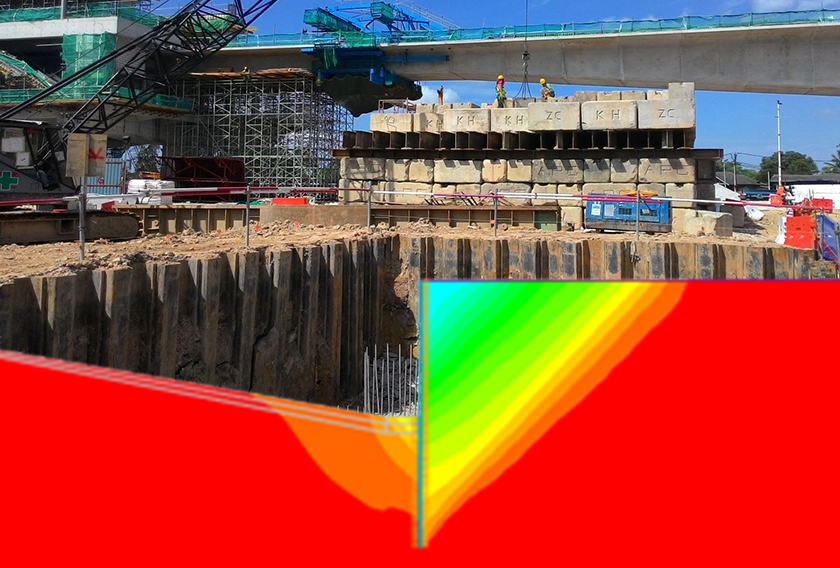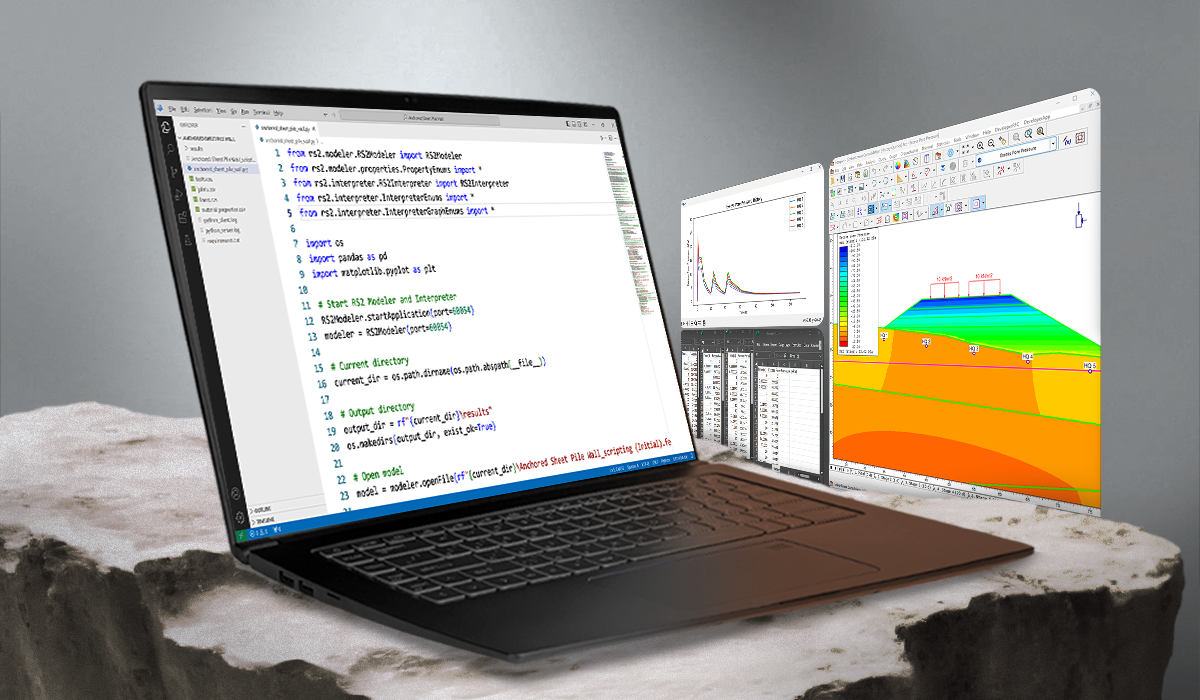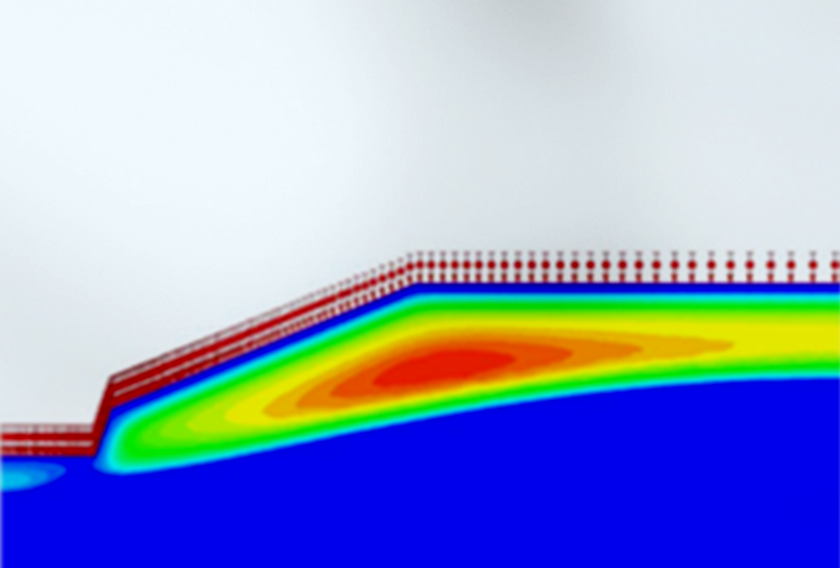Researchers Used RS2 to Develop an Optimized Solution to an Environmental and Geotechnical Problem
There are about a billion tires scrapped annually, with 4 billion tires currently sitting in landfills. That number should alarm you; these discarded tires take up vast landfill spaces, pose fire hazard risks, and are breeding grounds for disease-carrying pests. The need for innovative and sustainable building technologies is more pressing than ever, including how these old tires can be used in construction and geotechnical applications.

One such method is to make sand-tire chips from shredded recycled tires, and then use the mixture as backfill for cantilever retaining walls. But how does this affect the total displacement, global stability, and shear force and bending moment of the wall, and what percentage of tire to sand provides the most value?
A research study by Hachemi Djadouni, Habib Trouzine, Antonio Gomes Correia, and Tiago Filipe da Silva Miranda answers these questions and provides insight onto how recycled tires can be used for cantilever wall design. Here we’ll explore how RS2, our 2D finite element analysis program, was pivotal in their research and is helping solve environmental challenges in the geotechnical engineering industry.
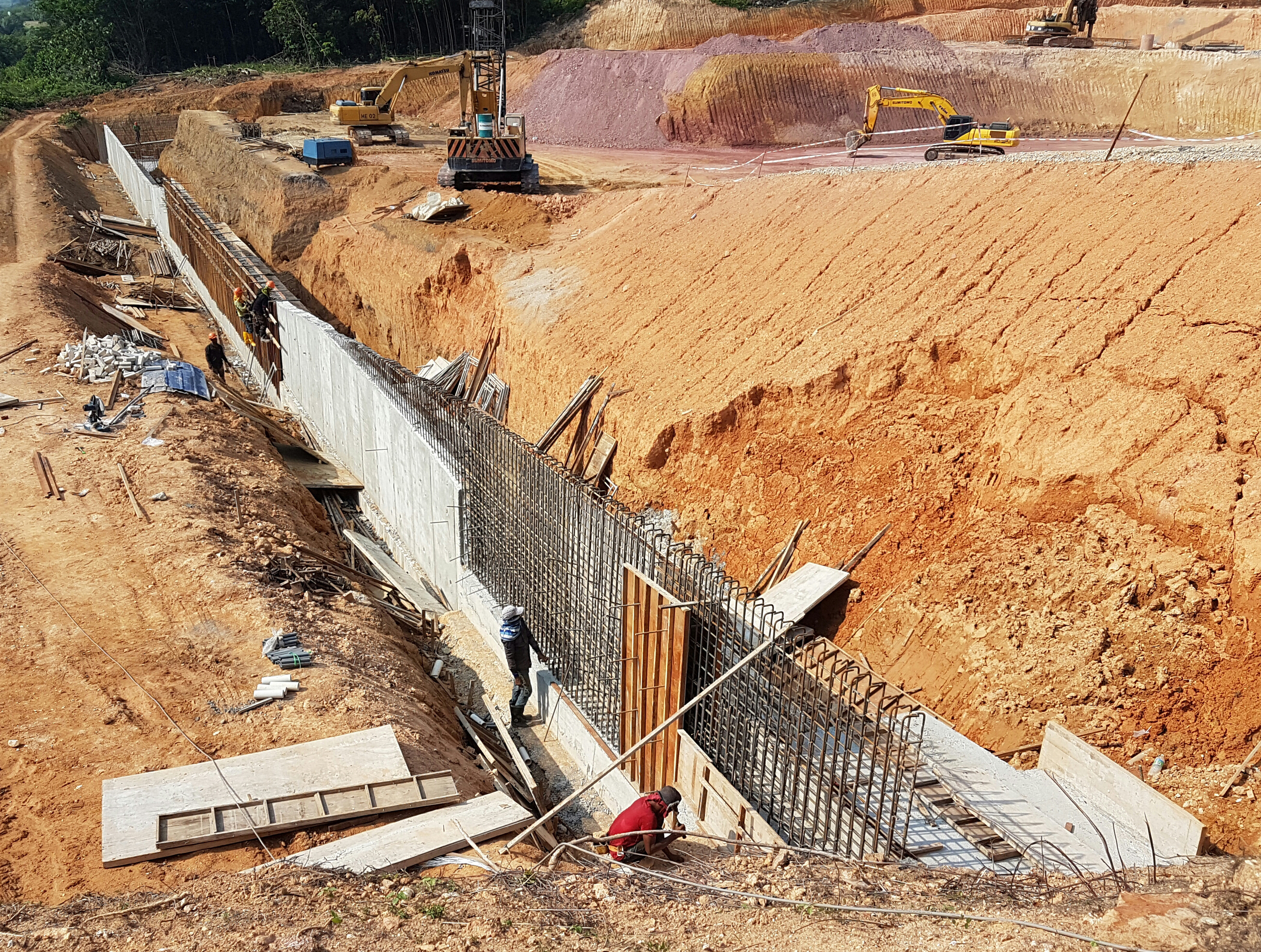
What Are Sand-Tire Chips, and How Are They Beneficial to Cantilever Retaining Wall Design?
Sand-tire chips (STC) are composite materials made from a mixture of sand and shredded tire chips. When you mix these components together, you get the solidity and load-bearing capacity of sand, plus the elasticity and lightweight nature of tire chips.
Tire chips are particularly valued for their ability to absorb and dissipate energy, which enhances the flexibility and resilience of the composite material. Using recycled tire chips also contributes to environmental sustainability by repurposing waste materials that might otherwise end up in landfills.
These mixtures are increasingly being considered for various geotechnical applications. Using them offers several advantages, like reducing the weight of mixtures compared to traditional sand or soil backfills (which lowers the overall gravitational forces acting on your structure and there’s less chance of sliding). The flexibility from the tire chips also allows the backfill to better accommodate movements and settlements without transferring excessive loads to structures.
To see what percentage of tire to sand is optimal for cantilever retaining walls, researchers used RS2 to model various walls with different backfill materials and analyzed the results.
What Does RS2 Do?
RS2 is our 2D finite element program for soil and rock applications designed to tackle various geotechnical challenges, including the analysis of cantilever retaining walls using tire-derived materials as backfill. It offers:
- Advanced capabilities for simulating soil-structure interactions.
- A comprehensive suite of material models, including the Mohr-Coulomb model.
- Automated tools for stability analysis using the shear strength reduction method.
- Flexible mesh generation with the ability to refine in areas of interest.
- Accurate prediction of displacements, pressures, and forces within geotechnical structures.
How Researchers Used RS2 To Analyze Cantilever Retaining Wall Backfill
With RS2, researchers modelled cantilever retaining walls with seven different backfills, ranging from pure sand to pure tire chips, to determine their effect on various aspects of the walls. Each mixture was named “STC,” followed by the percentage of tire chips in the ratio. STC66.54, for example, was 66.54% tire chips, while STC0 is pure sand.
RS2’s analysis results provided insights into the displacements, global stability, lateral earth pressures, bending moments and shear forces acting on the retaining wall for each case. Below are a few key results from the study:
Total displacement: The structural response and stability of the wall were both influenced by the backfill. Walls with sand alone (Figure 1) or pure tire chips (Figure 2) as backfill exhibited substantial total displacements – STC100 resulted in up to 8 cm of movement. And in both cases, the interface between the wall and backfill experienced shear failure.

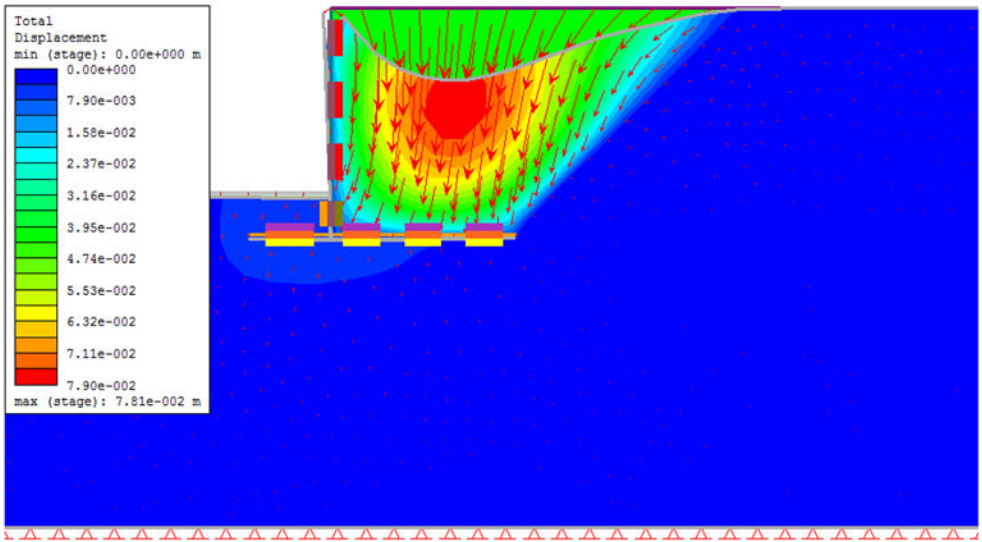
The STC mixtures reduced total displacements and enhanced wall stability, as only small failures were observed (see Figure 3) at the interface. This reduction in displacement is likely because of the tire chips, which lighten the backfill's overall weight and reduces stress on the wall, while sand helps the structure resist heavy surcharge loads.
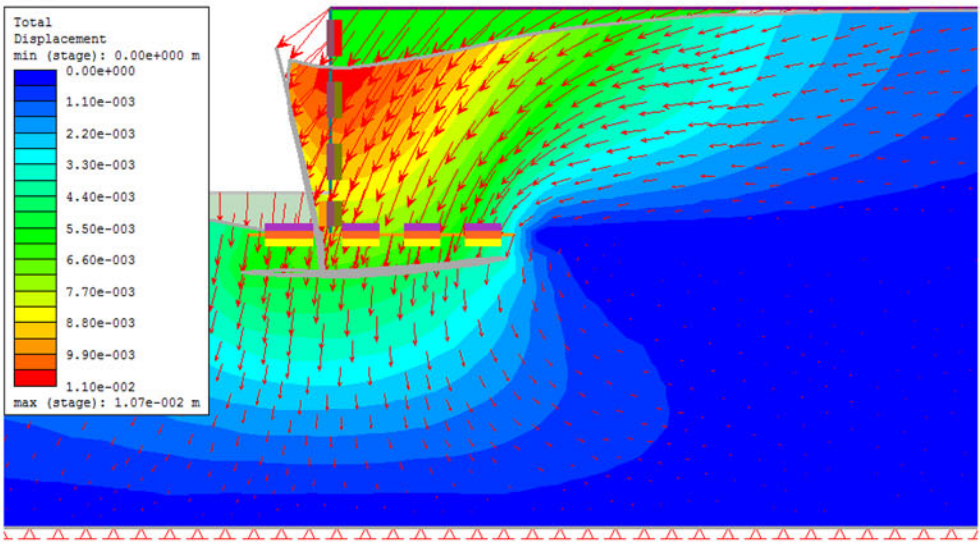
Global stability: The use of sand-tire chip (STC) mixtures enhanced the structural integrity of retaining walls compared to using sand alone (see Figure 4). These results show that STC mixtures achieved a higher factor of safety.
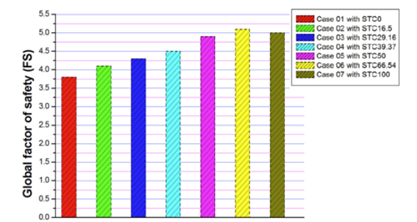
While the case using pure tire chips (STC100) also demonstrated a high factor of safety, this result was contingent on ideal conditions without surcharge loads – which are rarely found in practical scenarios. Under real-world conditions involving additional loads, the factor of safety for the STC100 scenario would decrease significantly, due to excessive settlements and failure of the wall.
The STC66.54 mixture showed superior performance by maintaining a higher factor of safety and confirmed its robustness under varying load conditions, making it a reliable choice for ensuring the global stability of retaining walls.
Vertical displacement: The maximum settlement occurred in the case where 100% tire chips (STC100) were used as backfill (see Figure 5), which significantly exceeded the settlement of the other mixtures. This shows that pure tire chips aren’t viable in practical applications, as their structural support is insufficient under typical load conditions.
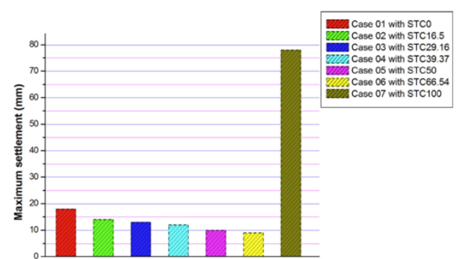
When the percentage of tire chips increased and the proportion of sand decreased, there was a notable reduction in settlement levels. Specifically, the mixture with 66.54% tire chips demonstrated the most favorable outcome in terms of minimizing vertical settlement.
Lateral displacement: Walls backfilled with sand alone (STC0) and those using pure tire chips (STC100) experienced the most significant lateral displacements, measuring 12 mm and 13 mm respectively (see Figure 6). The sand-tire chip (STC) mixtures resulted in considerably lower lateral displacements.

The STC66.54 mixture showed the most effective reduction in lateral displacement, with the smallest measurement at only 5 mm. This shows that including tire chips in the mix can help reduce movement. These results also suggest that a higher proportion of tire chips within the mixture influences this reduction, with displacement decreases ranging from 25% to 58% compared to STC0.
Bending moment and shear force: Consistent with structural principles, the maximum bending moment typically occurs at the base of the vertical wall near the footing. These results showed that retaining walls with sand-tire chip (STC) mixtures had reduced maximum shear forces and bending moments compared to sand alone (see Figures 7 and 8).
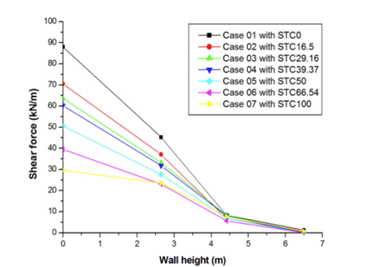
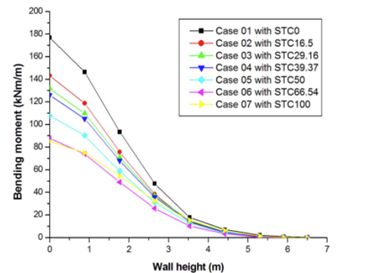
Key Takeaways from the Study
- Using sand-tire chip mixtures can be better than sand alone. STC mixtures enhanced the global stability of the retaining wall and improved its performance under various stress conditions in the models. For example, walls backfilled with STC mixtures exhibited higher factors of safety, less total and differential displacement, and lower lateral earth pressures compared to those using sand alone.
- STC66.54 was the most suitable retaining wall backfill material. The STC66.54 mixture, consisting of 66.54% tire chips and 33.46% sand by weight, was identified as the most effective. With the highest factor of safety (5.1), the most minimized horizontal and vertical displacements, the most reduced lateral earth pressures, and the lowest mechanical stresses on the wall, this mixture had an overall superior performance.
- STC100 (pure tire chips) is not feasible. Using pure tire chips resulted in substantial deformations within the backfill zone, and the structural integrity and functionality were compromised. While some proportion of tire chips is clearly beneficial, a balance with sand is crucial to maintain the necessary structural properties and stability.
Want to Use RS2 In Your Research? Here’s More That RS2 Can Do:
- Support Design. With RS2, you can analyze stress and deformation, stability, support design, and staged excavations. Whether your project or research is civil or mining based, above or below ground, it’s easy to get the best results.
- Slope Stability Analysis. RS2 can automate your slope stability analysis using shear strength reduction considering applied loads, complex groundwater flows and even liquefaction effects from dynamic analysis.
- Consolidation and Seepage Analysis. RS2's comprehensive consolidation and groundwater seepage analysis tools can analyze steady-state and transient flow alongside stress/deformation and thermal effects for dams, embankments, slopes, tunnels, and excavations.
Overall, RS2 was instrumental in demonstrating the viability of using recycled building materials (specifically scrap tire materials) as backfill for retaining walls. The simulations conducted using RS2 provided empirical evidence supporting the hypothesis that certain STC mixtures can enhance the performance and stability of cantilever retaining walls.
